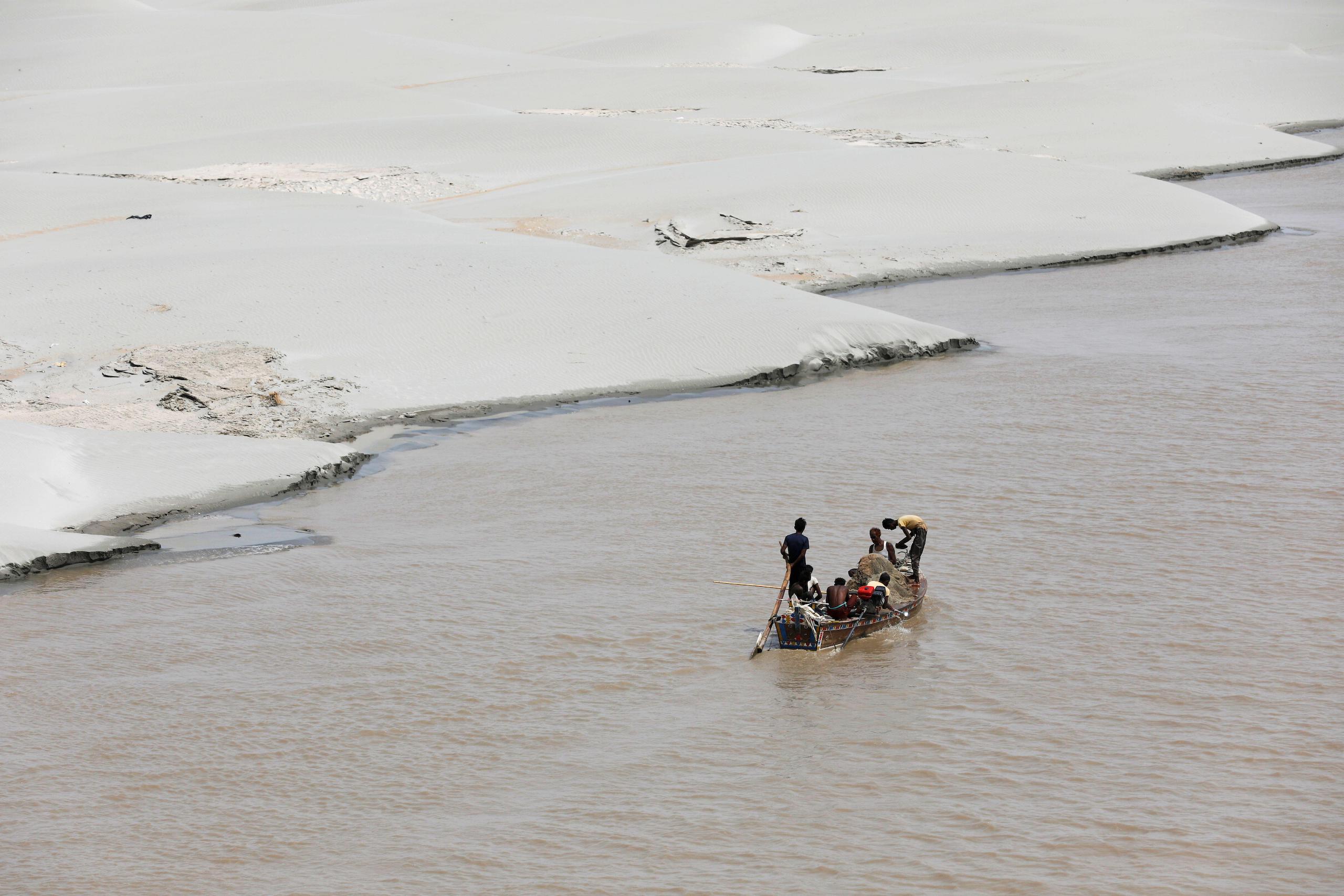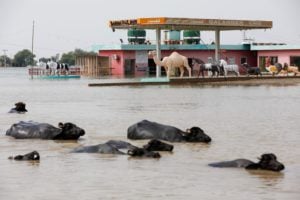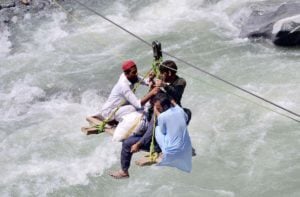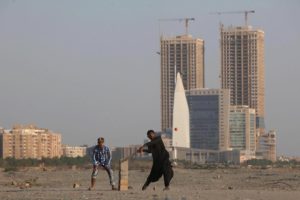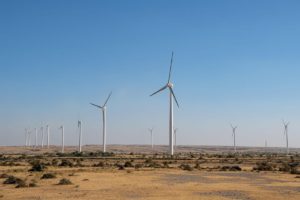As Pakistan’s climate change minister Sherry Rehman attends this year’s UN climate summit in Egypt, high up on her agenda is to showcase the prospectus for the Living Indus Initiative.
In September, Rehman announced the project, which was approved by Pakistan’s parliament in the wake of the worst floods in a decade. The Living Indus Initiative, which is being officially launched at COP27, is an umbrella initiative that spearheads and consolidates new and existing projects. Many of these aim to increase flood resilience in the Indus basin in Pakistan, while restoring it to good ecological health.
Rehman described the Living Indus Initiative as an “investment project” to The Third Pole, with a focus on “climate-resilient reconstruction” as Pakistan starts to rebuild after the floods this summer – which scientists have said were made more likely by climate change.
“It’s a living menu and investors can pick and choose parts,” said Rehman, calling the Living Indus Initiative Pakistan’s biggest series of climate adaptation projects. In total the initiative’s 25 projects will cost USD 11-17 billion, with 15 related to flood management, Rehman said.
The prospectus for the Living Indus Initiative sets out 25 priority interventions, through which it states it seeks to achieve a just transition, climate resilience and gender inclusivity.
Many projects aim to improve the health of the basin, including plans to clean up industrial effluent and wastewater from the river, recharge groundwater, eliminate plastic pollution from cities, control salinisation and create an urban forest. But they also focus on improving the lives of people in the basin, through 100,000 community ponds, a ‘Living Indus knowledge platform’, ecotourism, climate-resilient agriculture and fisheries, as well as “green infrastructure for flood control”.
They also seek to accelerate the transition to renewables and restore biodiversity – proposing the establishment of 500 protected areas and to offer climate and nature performance bonds.
Pakistan’s former climate change minister Malik Amin Aslam welcomed the approval of the Living Indus Initiative, describing it as the “tool to develop the country’s climate resilience for future floods”. The project was started under Aslam during the previous Pakistan Tehreek-e-Insaf (PTI) government and has been taken up by the ruling Pakistan Democratic Movement (PDM) coalition. Aslam said he was happy that the “ecological vision” carefully “crafted and initiated” by the previous government would be implemented without being altered.
Environmental lawyer Ahmad Rafay Alam called the prospectus the “next big thing” after Pakistan’s National Climate Change Policy of 2012 and the submission of its Nationally Determined Contributions.
Hassan Abbas, a water resources expert, described it as “futuristic”, with “a lot of focus on environmental sustainability and many links to the Sustainable Development Goals mapped”.
Water expert and chair of non-profit the Hisaar Foundation Simi Kamal, who was part of the consultation process for the Living Indus Initiative, said that with Pakistan in the throes of a climate disaster and COP27 underway, the document had come at just the right time to focus attention on the Indus.
About 90% of Pakistan’s population and more than three-quarters of its economic activity is located within the basin, according to the document outlining the Living Indus Initiative. More than 80% of the country’s arable land is irrigated by the Indus’s waters and nine out of the country’s 10 largest cities are within 50 km of it.
Aslam anticipated that more “floods will happen” along the Indus, as temperatures fluctuate and precipitation becomes more unpredictable due to climate change. He added that the ecology of the river system – home to at least 668 bird species, more than 150 fish species, and one of the world’s rarest mammals, the Indus river dolphin – is already under stress and will be further adversely affected.
Describing the Indus as “Pakistan’s lifeline”, Aslam told The Third Pole that the initiative “has the potential to be very big as it encompasses the whole country… reviving its dying ecology is critical if we are to cope with the enhanced climate stress.”
Saad Hayat Tamman, the national coordinator for the Living Indus Initiative, said that the consultation process with the public sector, private sector, experts and civil society began back in January 2022. The report was ready by April.
However, then the government changed, which slowed down the process. Around May, the Ministry of Climate Change took ownership of the initiative, seeking feedback from the provinces, relevant ministries and relevant water experts.
Rehman said the process of getting the green light from Parliament had been painstaking, describing “a very rigorous trial-by-fire process with the provincial governments”. Despite political differences between the provinces, consensus was built.
Many projects that were already underway are included in the Living Indus Initiative
| Sustainable Groundwater Governance through Provincial Water Acts | The Living Indus document looks at reasons for poor governance and where there is a need for legislation. Both Punjab and Khyber Pakhtunkhwa have laws that required them to set up provincial water commissions. However, implementation is lacking. The provinces of Balochistan and Sindh do not even have Water Acts. Islamabad, which is under federal control, has a law but is yet to form a commission. |
| Expanded GLOF-II | A project to manage the risks from glacial lake outburst floods is already being implemented in 10 districts of Gilgit-Baltistan and Khyber Pakhtunkhwa. The Living Indus document proposes to expand this to all vulnerable districts in the catchment area. |
| Indus Heritage Sites | The Living Indus Initiative proposes to protect 10 heritage sites in the basin. |
| Nature-Based Watershed Management | The report proposes detailed analysis of Pakistan’s 1,091 sub-watersheds to identify gaps in existing efforts and identify solutions involving local community participation. |
| Indus Protected Area | Pakistan has around 400 protected areas recognised by IUCN. The document proposes establishing 500 new protected areas. |
| Urban Forests along the Indus | The Ten Billion Tree Tsunami project will be supplemented with an urban forestation programme. |
Mega structures on the Indus not up for discussion
Dams, barrages, weirs and canals were first developed on the Indus by the British to enable irrigation, said Kamal. She described this taming of the river as driven by “sheer colonialism” to feed the British Empire.
“We need to build a new narrative where we take pride in the river, its floodplains and its role in Pakistan’s water value chain,” she said.
The Living Indus prospectus acknowledges the importance of nature-based flood solutions such as wetland restoration, mentioning that “riverbank filtration, underground dams, recharge area protection and enclosures” offer “more sustainable and cost-effective [water] storage” than dams. Other benefits listed include increased water security and agricultural productivity.
Abbas stressed that the real causes of the Indus’s degradation are the mega structures built across the basin to dam and divert water flow. However, he said, “there is no clear mention of this [in the Living Indus document], or even a comprehensive strategy to replace outdated mega structures with more sustainable and contemporary solutions”.
While the report does articulate the symptoms of the river’s ill-health, Abbas said not discussing dams meant that “everything proposed would struggle to sustain itself”.
Dismantling dams, barrages and canals is not a serious option in Kamal’s opinion. “Let’s be practical about it, let’s move forward and improve what we have, and manage that,” she said, adding that it may mean making some difficult choices.
“Certainly, we must decide not to build any more infrastructure [on the Indus],” said Kamal, so that “water losses are minimised” and the delta can be restored by “pressurising politicians to modulate their political stances [on hydro-engineering]”.
Living Indus now needs funding and cross-border cooperation
Rehman said that resource-stretched and debt-entrenched Pakistan has diverted “all the funds it had towards flood relief”.
“It’s going to be difficult to get focus on such [Living Indus] projects now that all funds will go towards recovery projects,” she said. “We will try to align some of them into resilient and adaptive design which is built into the Living Indus menu.”
Pakistan does not have people who are able to give a convincing rationale of the project and why it stands outAhmad Rafay Alam, environmental lawyer
The present government, said Rehman, aims to attract the interest of “multilaterals which have funding for long-gestation projects” for the USD 11-17 billion needed. “When we start working towards reconstruction, we can divert their [multilateral organisations’] attention to align with adaptation,” she added.
Abbas pointed out that “asking for funding here and funding there without creation of economic engines will not go a very long way.”
The funding issue, however, failed to dampen Aslam’s spirits. “Funds for some of these [projects] are available,” he said, but will need to be “augmented”. Others will need to be generated through “local as well as global financial options”, he added.
On this, Alam praised the aspect of the initiative that aims to improve Pakistan’s capacity to access global climate finance. “Some countries have had relative amount of success in accessing those funds. Unfortunately, for Pakistan, it does not have people who are trained to know how to navigate the UN red tape or be able to give a convincing rationale of the project and why it stands out.”
Even if funds are secured for these projects, giving the Indus a new lease of life will be difficult without cooperation from Pakistan’s neighbours, especially India. “It is very much a part of the implementation landscape outlined in the report,” Aslam responded, acknowledging that adapting to climate change and reviving the Indus’s ecology require regional collaboration and data sharing.
‘Federal overreach’ could jeopardise Living Indus Initiative
On the practical implementation of the Living Indus Initiative, Alam said: “I’d have wished for a little bit more clarity on sub-national governance.”
The document recommends an Indus Council be set up, but Alam said he did not see that happening as the “18th constitutional amendment puts many of the issues that are being spoken about within the clear mandate of the provincial governance”. The 18th Amendment, passed in 2010, gave Pakistan’s provinces legislative and financial autonomy.
To implement the policies, Alam said some “connecting tissue” is needed between the federal, provincial and even municipal authorities – but this is missing. “These projects sound good, but unless there is a coordinating mechanism… I fear there will be federal overreach and trampling of provincial authority. This could risk the effective implementation of such projects.”
Alam appraised the Living Indus Initiative as “ambitious” and “a bit silly” and at other times vague on details. But, he conceded, overall, he was pleasantly surprised that it shows an “evolution in environmental thinking” by the government.
